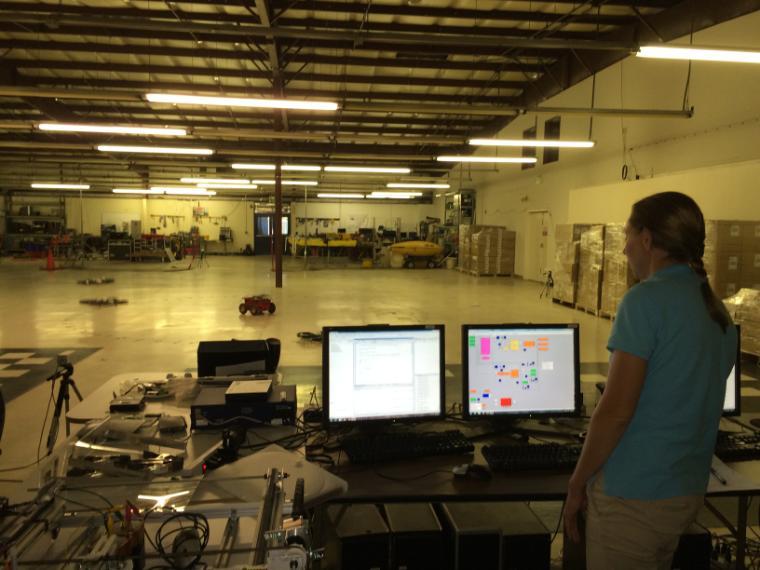
Robotics Students Stay Busy at the Lake and in the Lab
Summertime … and while the living might not be easy, it's not too shabby for the team in the Robotic Systems Laboratory (RSL). For years, this world-class field robotics program has had undergraduates, master's, and Ph.D. students running satellite missions for NASA and conducting research in partnership with the Monterey Bay Aquarium Research Institute. And now they are beefing up their operations in Lake Tahoe, adding drones to their fleet of aquatic vehicles that have been actively researching and mapping the geology of the lake for more than a decade in partnership with the U.S. Geological Society and University of Nevada, Reno.
In June the team headed to Tahoe to test a prototype fleet of AUVs (autonomous underwater vehicles), demonstrating the ability to control the formation of the robots, which may ultimately support tasks such as oil well inspection and environmental cleanup. They also tested a new prototype of an ROV (remotely operated vehicle) made from hobby-class electronics and outfitted with a sonar tracking system and cameras to give a view of the lakebed to the crew on the RSL's boat—Christopher Kitts, lab director and associate professor of mechanical engineering, Ph.D. student Michael Neumann '03, Mike Vlahos '14, and Kristin Berbawy, a teacher at Fremont’s Irvington High School who has interned with the team the past two summers as part of IISME (Industry Initiatives for Science and Math Education). Berbawy credits Kitts with helping her get a robotics course off the ground at Irvington last year.
Another friend of the RSL, Lloyd Droppers (who works at an astronautics start-up) was in one of the lab’s kayaks, helping with retrieval and management of the ROV’s tether, and Ph.D. student Jasmine Cashbaugh was on shore hoping the wind would die down long enough to get her drones in the air. (Sadly, it didn't happen that day.)
The ROV was performing admirably until Vlahos noticed the gauge was registering 96 percent humidity; the robot was pulled up out of the water for a quick inspection, and a leak was spotted coming from the plug in a donated piece of equipment—a setback that couldn't be mended with the zip ties, clamps, cable, or any of the other various and sundry items kept aboard that might be utilized for a quick fix. "As they test these prototypes and put new equipment in the water, the students encounter a lot of unexpected challenges. We learn far more than we wanted to learn," said Kitts with a laugh as the day's mission was called to a halt.
When the team returned to the Bay Area, Cashbaugh resumed her research at the RSL's facility at Moffett Field's NASA Ames Research Park. She is determining how best to control a group of quadrotor drones to fly autonomously in formation following a Pioneer Landrover. Positioning them around a testbed area marked with electrical tape to delineate the angle of separation between each robot, she tests them in a range of separation angles to find the ideal configuration for tracking a moving object to produce the best overall picture. Cameras mounted on the front of the drones send location data to a control computer, which uses Simulink and Matlab to compute drive commands and then transmits instructions to individual computers that run the aircraft. All tests are videotaped as she moves the robots around the field. It's a painstaking process but Cashbaugh said, "The project is going well. I've gotten a lot of the math worked out, and the results I get from using two or three drones can be applied to larger groups of robots."
The RSL already has customers clamoring for this technology. They are in conversations with SCU's Facilities Department to explore useful applications and have already conducted a test inspection of the University's extensive solar arrays, which may lead to identifying normal wear and tear as well as finding "hot spots" using an infrared camera. The team has also had the drones performing initial demonstrations of environmental monitoring, working with a Tahoe group to survey growth of the endangered Tahoe Yellow Cress plant, which often grows in spots that are not easily accessible. In addition to measuring the extent of growth, Kitts notes that the RSL's nearinfrared camera could detect chlorophyll activity in the plant to gauge its health. "The potential for drones is tremendous," he said. "Another of our students is researching the use of drones for delivering medicine to remote villages in Africa. This is just the beginning of some very exciting work."